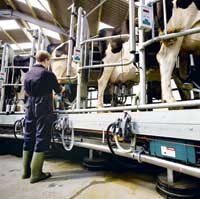Dairy Event 2010: Parlour testing helps prevent problems

Expanding your herd in small steps and accepting longer milking times, rather than installing a new parlour, may be a good example of asset sweating. But short-term savings are at risk of being wiped out by longer term mastitis problems – unless routine parlour maintenance keeps apace.
It is important to remember parlours are like cars: Regular servicing is based on work done, not calendar months, says parlour specialist Ian Ohnstad from The Dairy Group. “We advocate both static and dynamic testing every 1500 hours. So when you run the parlour for 22 hours a day, it needs servicing more often, not just an annual check. Similarly, liner changes should be according to numbers of cows milked, not months used.”
Problems such as a vacuum level failure will lead to cow discomfort and changes in the colour and feel of teats. But this is a short-term issue. Real and lasting damage to teat ends occurs over the medium to long term, from weeks of poor parlour function. While there is some weakening of the teat closing mechanism, more often it’s the formation of hyperkeratosis.
“Hyperkeratosis is the production of excess keratin and skin cell tissue on the teat end which causes ‘fronding’. It’s a bit like getting a callous on your hand where the skin thickens,” explains Mr Ohnstad.
These cells normally line the inside of the teat canal and have a major role in trapping bacteria when they go up the canal. When damaged, this self-defence mechanism becomes compromised. Fronding also makes it hard to properly clean teats (an important part of controlling environmental mastitis) before attaching the cluster.
Teat damage results from several causes, excess plant vacuum level being the most obvious one. However, incorrect vacuum at the teat end happens in a variety of ways, all of which can be detected during routine parlour testing. Over-milking, generates excess vacuum at the teat end. Pulsation units operating incorrectly will mean the liner-open phase is extended. “So the teat is exposed to longer periods of unrelieved vacuum, but this is something we pick up at a routine parlour service,” says Mr Ohnstad. Finally, liner design also has an influence and should not apply an excessive pressure at the teat end.
What’s more, a poor operator routine can cause over-milking: Either directly or through a lack of teat stimulation causing over milking before milk flow starts. Mr Ohnstad also points out that those who are lax about post-milking disinfection make teats dry and cracked.
Fortunately, it is possible to rectify teat-end damage. Teat skin condition is perhaps the easiest to solve with a switch to a quality disinfectant containing suitable skin conditioner – and applied to the whole teat, not just the end. Mr Ohnstad says removing the cause makes symptoms disappear. “A good dry period of eight weeks has a marked effect,” he adds.
He recommends that any vet or independent plant tester should not only carry out static and dynamic tests to ISO 2007 standards, but also be capable of interpreting the results and suggesting any corrections. The ideal time for putting a parlour through its paces is when most cows are at peak yield. “Testing when there are stale cows milking, most plants perform well,” he adds. “In a seasonal calving herd we can do a static test during the dry period, so that any problems are easily fixed. This is then followed by a dynamic test in early lactation.”
Teat scoring is part of the dynamic test to monitor changes and offers a base line from which to chart progress in a new parlour. Teats are scored using an internationally agreed system, designed by the Teat Club International, based on visual descriptions on a scale of one to four. On a herd basis, scoring reveals that hyperkeratosis naturally follows a lactation curve, says Mr Ohnstad. “There is more of it at peak milk yield than in freshly calved cows or stale milkers. Generally we score cows at all stages of lactation and different parities and we look for a minimum of 80 cows or 20% of the herd.”
